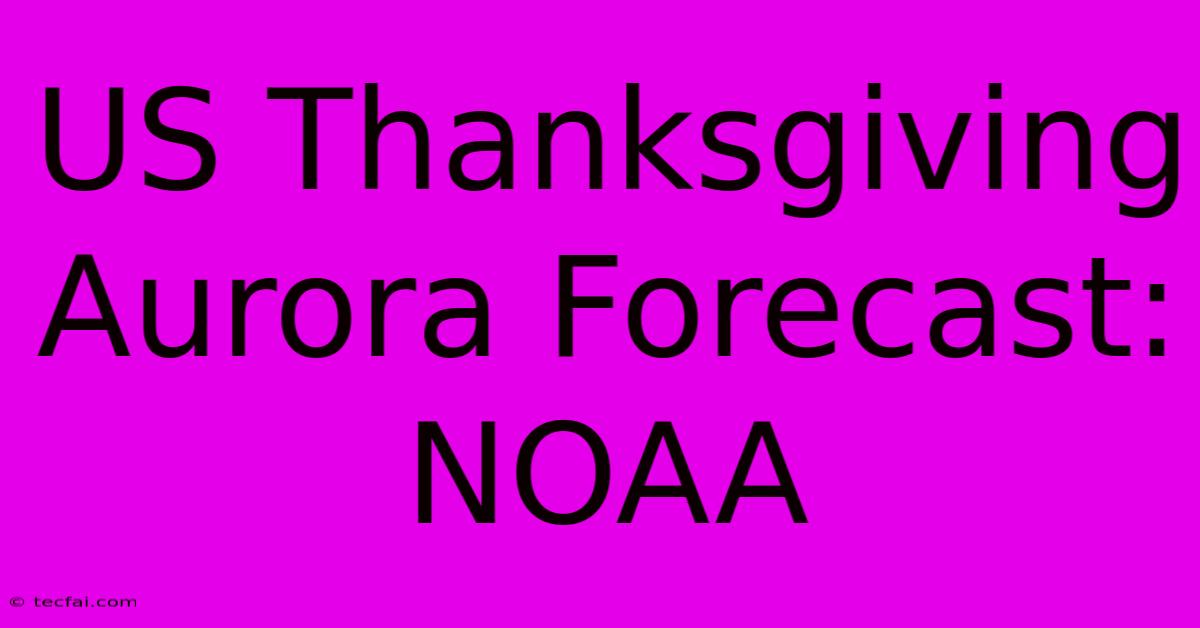US Thanksgiving Aurora Forecast: NOAA

Discover more detailed and exciting information on our website. Click the link below to start your adventure: Visit Best Website tecfai.com. Don't miss out!
Table of Contents
US Thanksgiving Aurora Forecast: NOAA Predictions and Viewing Tips
Thanksgiving is a time for family, feasting, and…auroras? Believe it or not, the celestial spectacle of the Northern Lights might grace the skies over parts of the US this Thanksgiving. But will you be lucky enough to witness this breathtaking display? Let's dive into the NOAA forecast and learn how to maximize your chances.
The National Oceanic and Atmospheric Administration (NOAA) is the go-to source for space weather predictions, including aurora forecasts. They monitor solar activity, geomagnetic storms, and other factors that influence the aurora borealis' visibility. While a precise prediction for a specific location on Thanksgiving is impossible weeks in advance, we can leverage their data to understand the likelihood of an aurora sighting.
Understanding the NOAA Space Weather Prediction Center (SWPC)
The SWPC uses various metrics to assess aurora visibility. Key factors include:
- Kp Index: This is a crucial indicator of geomagnetic activity. A higher Kp index (typically 5 or higher) suggests stronger auroral displays, potentially visible at lower latitudes.
- Solar Wind Speed and Density: Fast solar winds and high density can fuel geomagnetic storms, increasing the chances of auroras.
- Bz Component of the Interplanetary Magnetic Field (IMF): A southward-directed Bz component is particularly effective at funneling energy into the Earth's magnetosphere, triggering auroras.
NOAA provides forecasts and real-time data on these parameters. By monitoring these predictions leading up to Thanksgiving, you can get a better idea of the aurora's potential visibility in your area. Remember, forecasts are subject to change based on solar activity.
Increasing Your Chances of Seeing the Thanksgiving Aurora
Even with a favorable NOAA forecast, several factors influence your ability to witness the aurora:
- Location, Location, Location: Head to areas with minimal light pollution. The darker the skies, the better your chances of seeing the aurora. Northern states like Alaska, Minnesota, North Dakota, Montana, and parts of Washington and Oregon historically offer the best viewing opportunities in the US.
- Timing is Key: Auroras are most active during nighttime hours. Check the NOAA forecast for predicted peak times of activity.
- Weather Conditions: Clear skies are essential for aurora viewing. Cloudy conditions will completely obscure the display.
- Patience is a Virtue: Auroras can be unpredictable. Even with a favorable forecast, you may need patience and persistence to witness the show. They can appear and disappear quickly.
- Use Aurora Forecasting Apps: Numerous apps utilize NOAA data and provide user-friendly predictions and alerts, making it easy to stay informed.
What to Expect During a Geomagnetic Storm
During a geomagnetic storm strong enough to produce visible auroras in the lower 48 states, you might witness a faint, greenish glow on the northern horizon. In more intense storms, the aurora can become more vibrant, with shades of green, red, purple, and even blue. The display's intensity and color variations depend on the strength of the geomagnetic storm and altitude.
Conclusion: Thanksgiving Aurora – A Potential Treat
While no one can guarantee an aurora borealis on Thanksgiving, utilizing NOAA's space weather predictions and taking the necessary steps to enhance your viewing chances increases your odds. Keep an eye on the forecast in the weeks leading up to the holiday, and you might just be rewarded with a spectacular Thanksgiving surprise! Remember to check weather forecasts alongside the aurora predictions for the best chance of a successful viewing experience. Happy Thanksgiving, and happy aurora hunting!

Thank you for visiting our website wich cover about US Thanksgiving Aurora Forecast: NOAA. We hope the information provided has been useful to you. Feel free to contact us if you have any questions or need further assistance. See you next time and dont miss to bookmark.
Featured Posts
-
Powerball Jackpot Hits 100 Million
Nov 28, 2024
-
Who Is Jay Bhattacharya Nih Candidate
Nov 28, 2024
-
New Zealand Vs England Test Scorecard
Nov 28, 2024
-
Fathers Role In Db Hijacking Revealed
Nov 28, 2024
-
Worlds Longest Fight Gets An Upgrade
Nov 28, 2024
